Competition details
If we have followed the guide in order, the main interface should look something like this (the MeOS + Divisionsmatchberegning result source is used on the image, but that is not important right now):
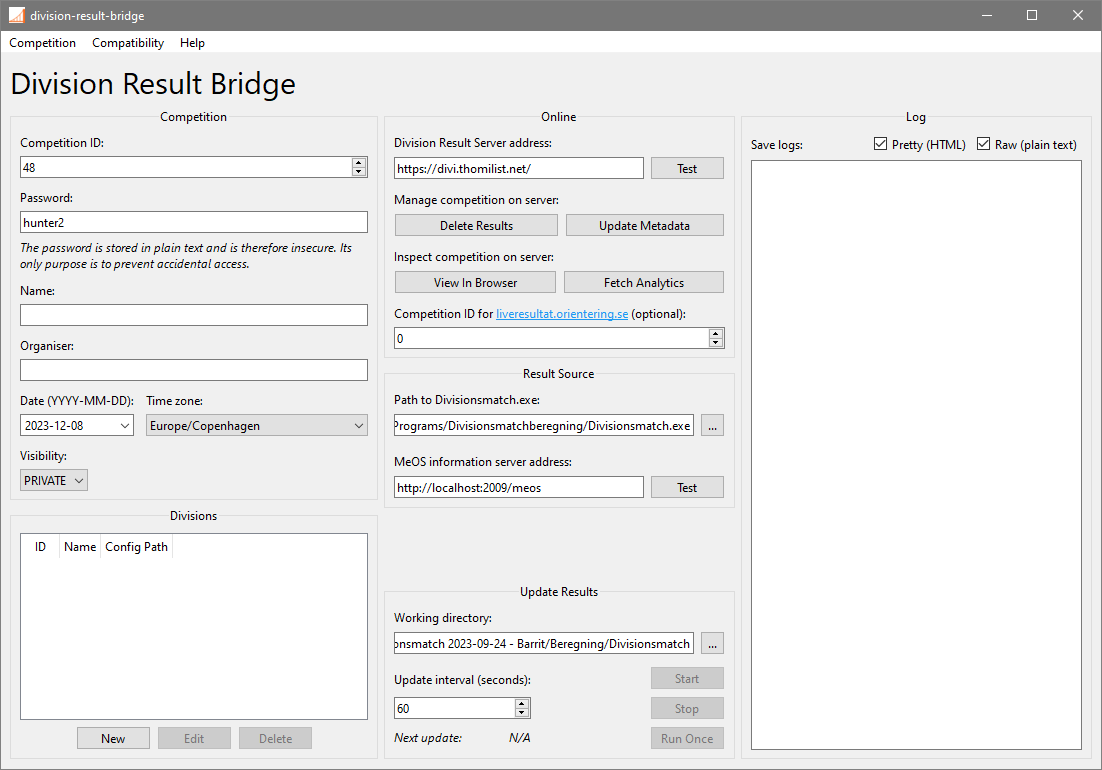
We have made good progress, but there are still some empty fields left. In fact, we haven't even touched the Competition, Divisions or Online panes at all! Let's change that, starting with the Competition pane.
Competition
There are quite a few fields in the Competition pane. Some of them relate to the real-world event, while others define interactions with the result server.
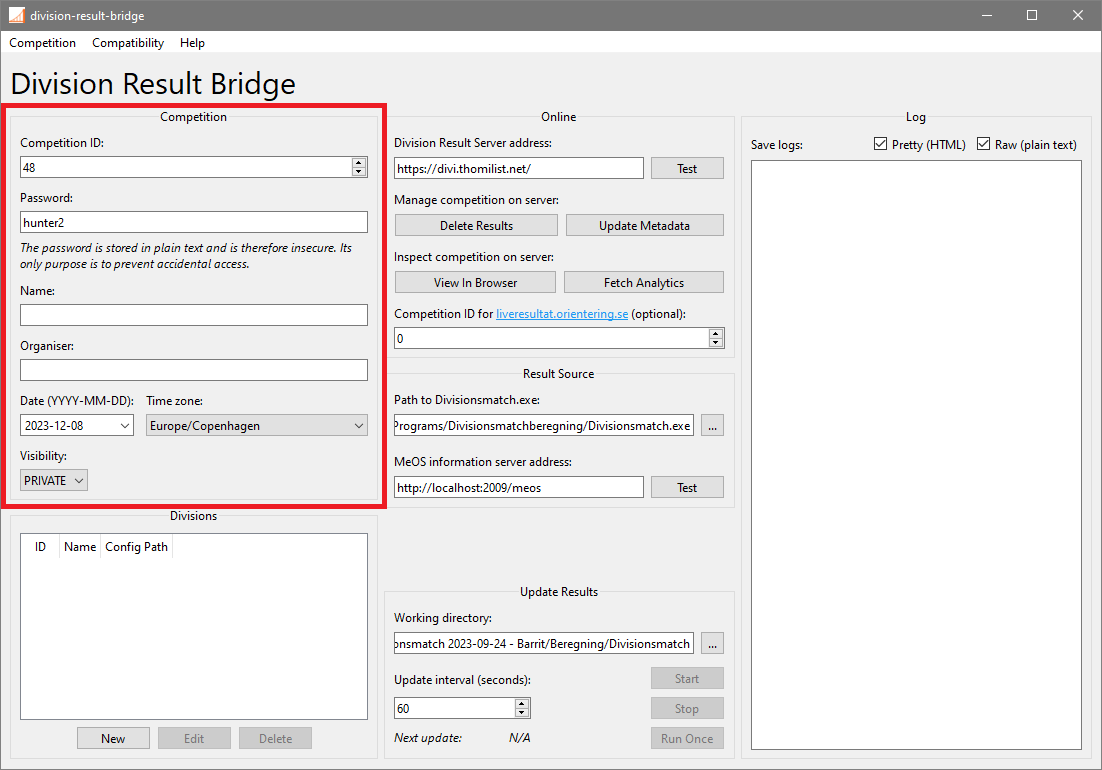
The first two fields are labeled Competition ID and Password. The values of these credentials were determined when we created the competition; the password chosen by us, and the competition ID assigned by the server. The credentials for a given competition cannot be changed, though changing the values in these fields allows us to work with a different competition. We only have one competition in play, however, so we will leave the credentials untouched.
The next four fields describe the real-world competition. Name is the name of the competition, while Organiser is the name of the organiser. The Date (YYYY-MM-DD) field denotes the date of the competition in the indicated format. As an example, the 24th of September 2023 becomes 2023-09-24. Finally, Time zone is the time zone at the real-world location where the competition takes place. Division Result Bridge will suggest a time zone based on the configuration of the operating system on which it is running. The values of Name, Organiser and Date (YYYY-MM-DD) are shown to users on the result website.
The result server uses the date and time zone on its front page. Here, all competitions are listed in cronological order, and any competitions scheduled for the current date will be highlighted in an additional list at the top of the page.
If we are using the MeOS + Divisionsmatchberegning result source, and MeOS' information server is online, there is a little shortcut available: Head up to the Competition menu and select Import metadata from MeOS.
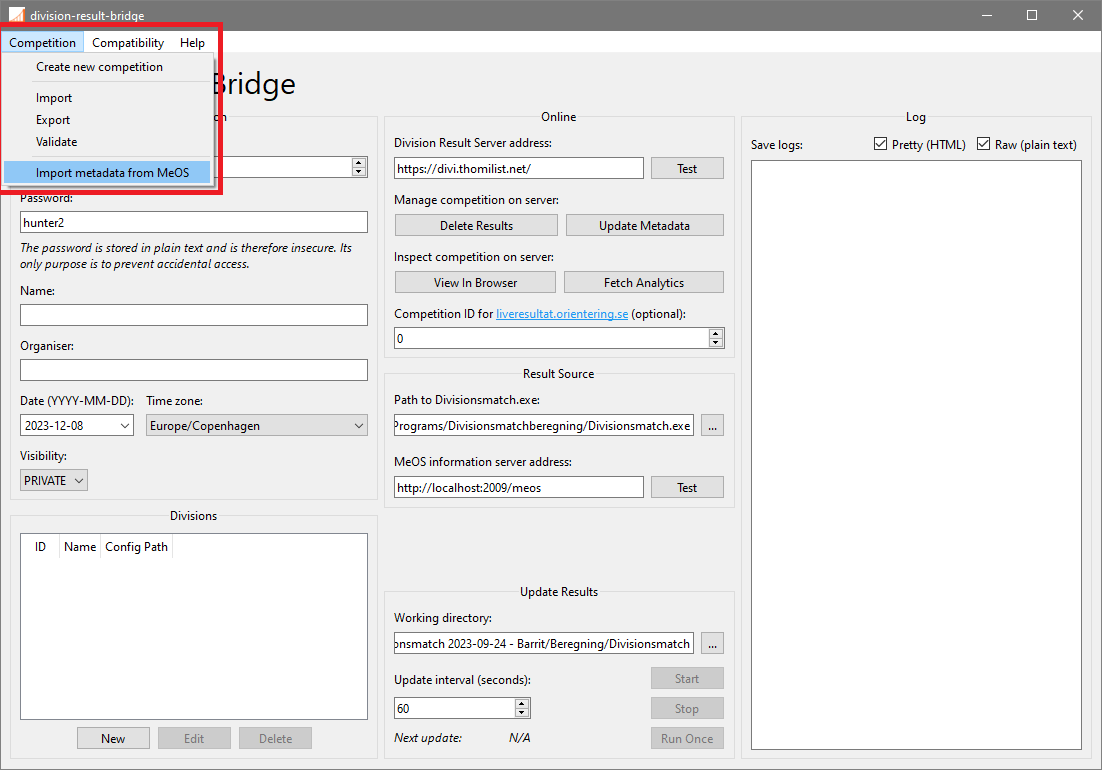
For each of competition name, date and organiser fields filled out in MeOS, the corresponding field in Division Result Bridge will be filled out.
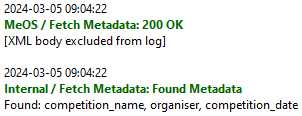
There is one more setting in the Competition pane: Visibility. This setting determines if and how the competition can be found on the result server website. Three options are available:
| PRIVATE | The competition cannot be accessed via the website. This is the default option. |
| HIDDEN | The competition can be viewed on the website via a direct link, but it is not listed on the front page. |
| PUBLIC | The competition can be viewed on the website and is listed on the front page. |
Let's set the visibility to HIDDEN for now. This way, we will be able to see our competition as we work on it, but other people are unlikely to stumble upon our unfinished work. Note that changes made in Division Result Bridge are only applied on the result server after we upload them — more on that in a moment.
Divisions
It is finally time to configure our divisions. In the Divisions pane, we find the division table — and don't worry; this isn't an elementary school maths lesson. There are three buttons along the bottom of the table: New, Edit and Delete. Press the New button to open the division editor.
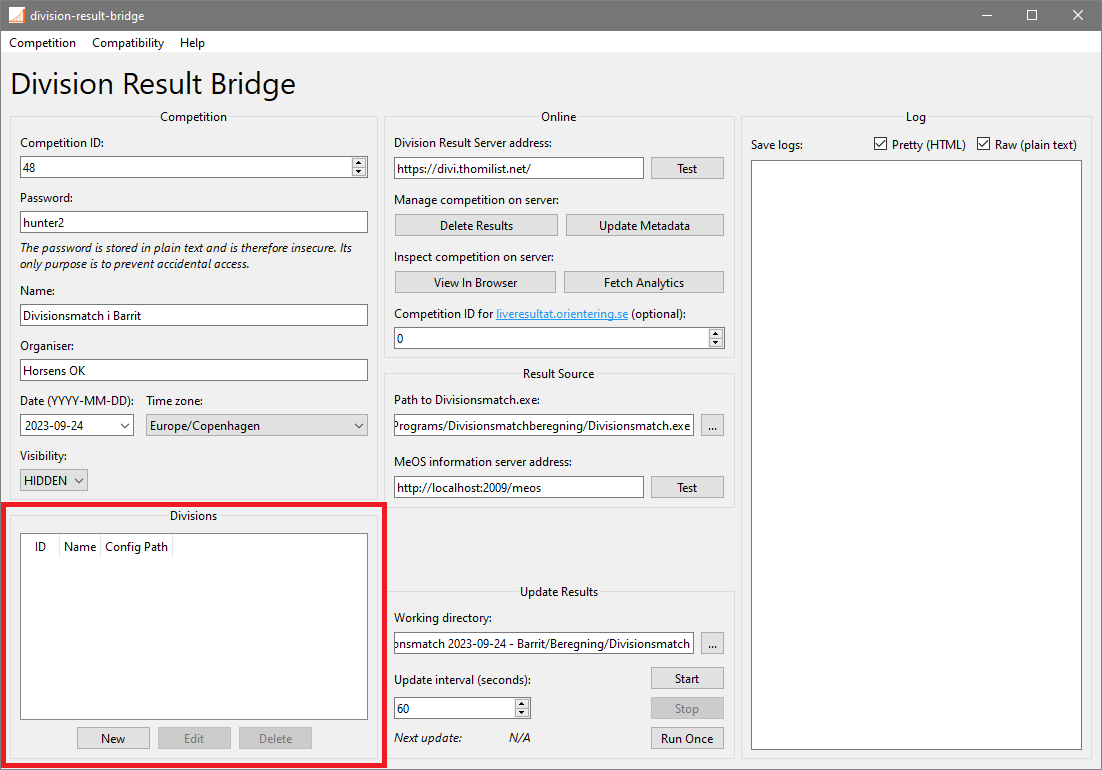
When using the MeOS + Divisionsmatchberegning or IOF XML file + Divisionsmatchberegning result sources, the division editor has the fields Division ID, Name and Path to division config file (.divi).
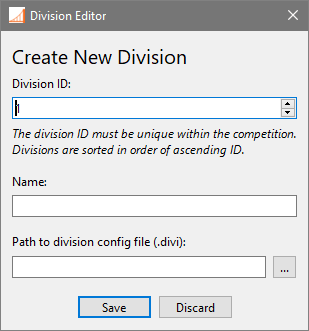
Whenever using the Divisionsmatchberegning result source, however, the Path to division config file (.divi) field is replaced with the Information server address field.
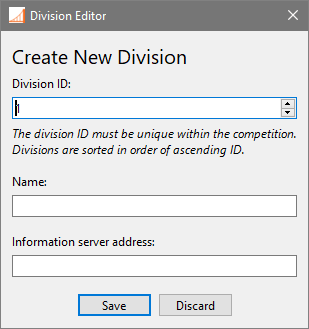
Unlike the Competition ID, the choice of Division ID is ours to make. For competitions with multiple divisions, the Division ID determines the sorting order of the radio buttons used to select divisions on the result website. Divisions are sorted in ascending order, and all Division IDs within the same competition must be unique. For competitions with only a single division, the Division ID is irrelevant.
The Divisionsmatchberegning field holds the label for the division, which is attached to its division selection radio button on the result website. Anything goes, but we should try to keep it concise to aid viewing on narrow displays, e.g. "2nd division".
The Path to division config file (.divi) field is where the path to the division configuration file exported from Divisionsmatchberegning is provided, if applicable. The configuration file is of course unique for each division.
Due to implementation details, the result server is only compatible with certain layout settings in the division configuration file. In Divisionsmatchberegning, these settings are found through the Print menu (which, despite the name, applies to more than just printing), and then Setup.... Specifically, the Html CSS setting must be unchecked, and the Layout must be set to Blå overskrifter. It is strongly recommended that any division configuration files pointed to in Division Result Bridge are reserved exclusively for Division Result Bridge, and that separate copies are made for other purposes, such as printing.
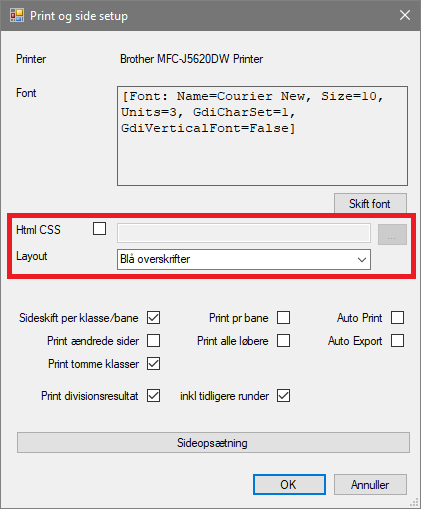
As mentioned, when the Divisionsmatchberegning result source is in use, the division editor presents the Information server address field. This is the network address of the information server opened in Divisionsmatchberegning. For competitions with multiple divisions, each division will be associated with a unique instance of Divisionsmatchberegning, each with its information server open on a unique network address — usually accomplished by using different ports if multiple instances of Divisionsmatchberegning are running on the same computer. In Divisionsmatchberegning, the information server dialog can be accessed through the Information menu, and then Information Server.
Once the three fields are filled out, we can press the Save button to save the division and close the division editor. If the competition has multiple divisions, we press the New button again and repeat the process to add another division. Additionally, existing divisions can be edited or deleted by selecting them from the division table and using the Edit and Delete buttons, respectively.
Liveresults
While division matches are primarily about competitions between whole clubs, they do also contain individual results within the various classes. Services to publish live, individual results online already exist, e.g. Liveresults.
For convenience, a link to the corresponding Liveresults page can be shown on the division result page. In the Online pane, the field Competition ID for liveresultat.orientering.se (optional) can be found. When set to 0, it does nothing. However, as the name would suggest, we can enter the competition ID of our Liveresults competition here. Doing so will add a prominent, orange button linking to the Liveresults page. It will also update the link in the label, so if we click it, we can easily verify that the ID is correct.
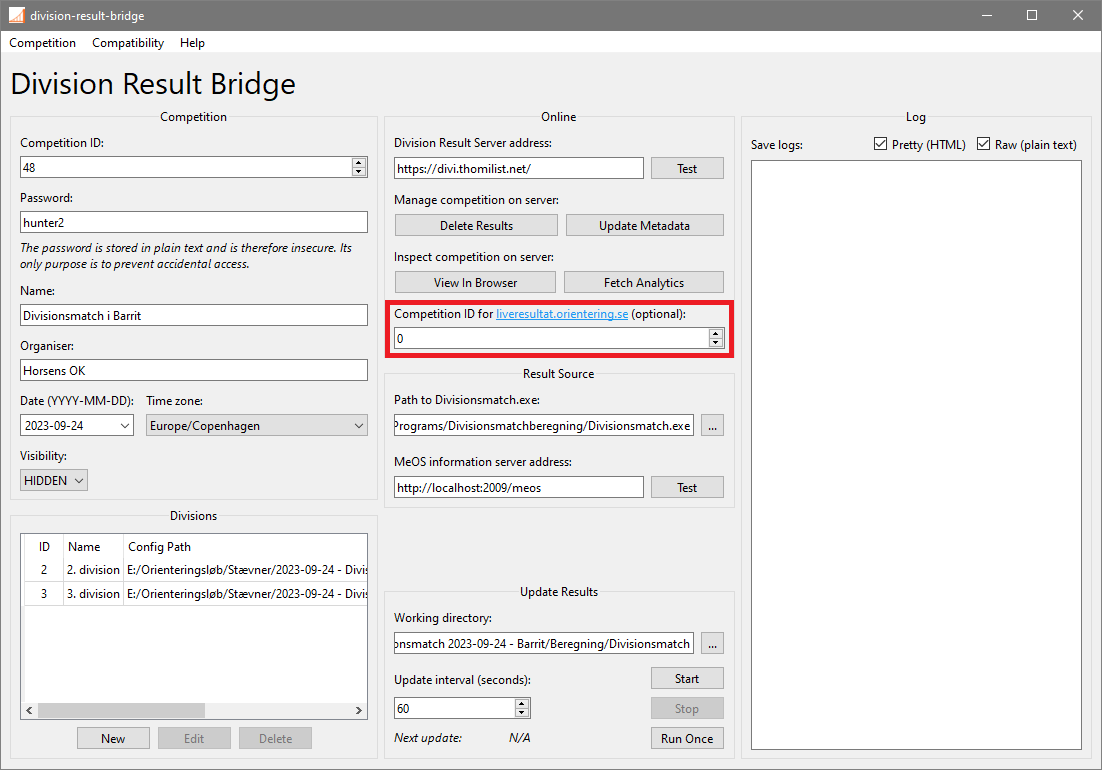
Validate configuration
At this point, our competition is fully configured — or at least it should be. To help us run a quick sanity check, Division Result Bridge includes a basic configuration validation tool. This can remind us to fill out empty fields, and it can check the validity of file system paths. However, the tool is by no means perfect: It does not validate semantics, spelling or the status of network resources, to name just a few limitations.
To run the validation tool manually, head to the Competition menu, then select the Validate option.
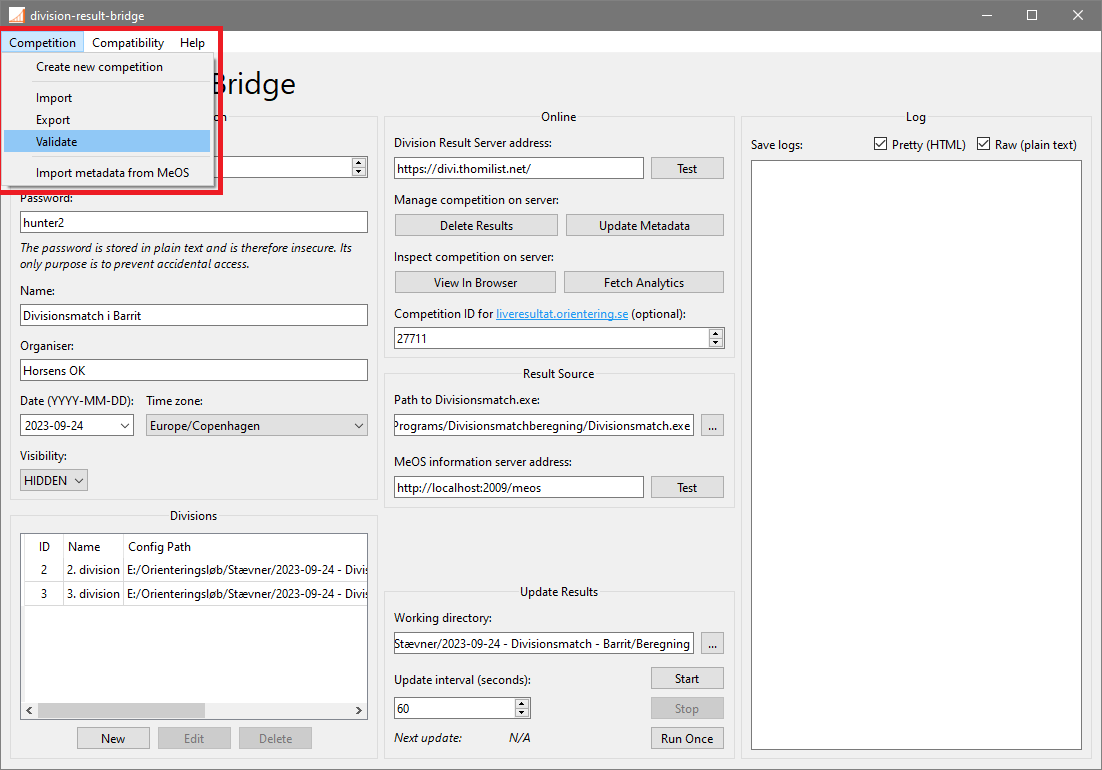
The result of the validation is printed to the log, and every failed check yields a warning. We should be sure to read them, as the warnings include their reasons in order to guide decision making: Is something specified incorrectly (or not at all), or is the warning safe to ignore? The latter case can arise when something is intentionally omitted or, in some cases, due to false positives. And, to reiterate, the tool finding 0 issues does not mean that the configuration is flawless, so we should merely consider the validation tool a supplement to the good old manual inspection.
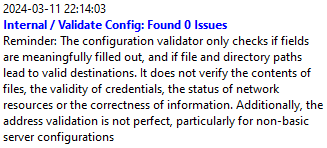
In addition to manual runs, the validation tool also runs automatically whenever Division Result Bridge is started.
Upload changes
When introducing the Visibility setting, I briefly mentioned that changes need to be uploaded to the server to take effect. Well, we have made a bunch of changes by now, so how about we give it a try? We look at the Online pane again, but this time, we focus our attention on some of the buttons.
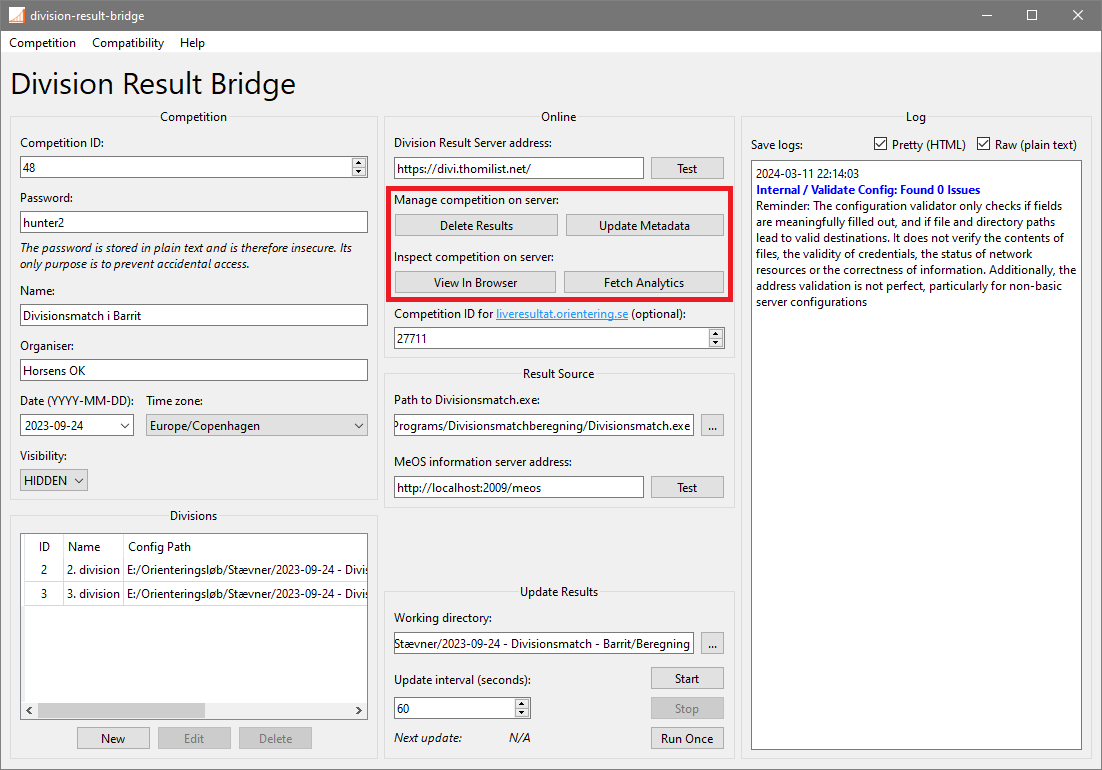
First, the Update Metadata button. Pressing this button bundles up all the competition and division metadata that we just provided, uploads it to the Division Result Server at the address we have specified, and, if the credentials are valid, updates the metadata of our competition. The response from the server will be printed in the log.
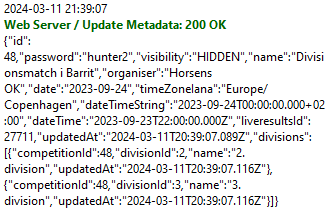
Of course, seeing the metadata printed to a soulless log output is not nearly as exciting as viewing the actual result page. Fortunately, the aptly-named View In Browser button allows us to easily do exactly that.